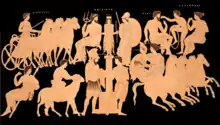俄諾瑪俄斯
俄諾瑪俄斯(希臘語:Οινόμαος)是古希臘神話中的比薩王,[1]那伊阿得斯哈珀娜[2]或普勒阿得斯斯忒洛珀[3](有時也被認為是俄諾瑪俄斯的配偶)[4]和戰神阿瑞斯之子,希波達彌亞之父。除去斯忒洛珀的可能性之外,他的妻子也可能是阿爾戈斯的Evarete(阿克里西俄斯和歐律狄刻之女)。另外達那俄斯之女Eurythoe也被認為是他的母親[5]或配偶。[6]除去希波達彌亞,他的孩子還有留基伯(因愛戀達佛涅而死)和阿爾卡珀。鮑桑尼亞認為俄諾瑪俄斯的父親不可能是神而是人類。[7]歐里庇得斯著作《在陶里斯的伊菲革涅亞》中的譜系證據顯示,俄諾瑪俄斯是特洛伊戰爭的前二代之人,是亞崔迪、阿伽門農和墨涅拉俄斯的祖父。

俄諾瑪俄斯、希波達彌亞和奧利匹斯眾神,一個古代花瓶上的圖畫
珀羅普斯與俄諾瑪俄斯之死
珀羅普斯想要娶俄諾瑪俄斯之女希波達彌亞為妻,但是俄諾瑪俄斯曾經得到一個預言:他將會被自己的女婿殺死,爲了阻止這一事情發生,他通過戰車賽殺死了13個來向希波達彌亞求婚的人,並將他們的頭顱釘在宮殿的木柱上。[8]爲了娶到希波達彌亞,珀羅普斯決定與俄諾瑪俄斯比賽。爲了保證不失敗,珀羅普斯向波塞冬求助,後者交給他一輛飛馬拉的戰車。[9]珀羅普斯和希波達彌亞換掉了俄諾瑪俄斯車輪上的車軸,因此俄諾瑪俄斯因翻車被韁繩纏住,而被馬拖死了。俄諾瑪俄斯的車夫彌爾提洛斯倖存,但最終為珀羅普斯所殺。
彌爾提洛斯死前對珀羅普斯下了詛咒,導致後者的許多後代如阿特柔斯、梯厄斯忒斯、阿伽門農、墨涅拉俄斯和俄瑞斯忒斯都不得善終。同時彌爾提洛斯位於奧林匹亞的墓地也被認為是一個不祥之處。俄諾瑪俄斯的戰車賽被認為是古代奧林匹克運動會的起源之一,并產生了一些厄利斯傳說。[10]
參考資料
- In the ancient territory of Pisa lay Olympia.
- Theoi Project: Harpina (页面存档备份,存于).
- Hyginus, Fabula 84 ("Oenomaus, son of Mars and Asterope, daughter of Atlas"), Fabula 250 ("Oenomaus, son of Mars by Asterie, daughter of Atlas").
- Pseudo-Apollodorus, Bibliotheke 3. 110 - 111; Pseudo-Hyginus, Astronomica 2. 21; he was depicted on the pediment of the Temple of Zeus at Olympia with Sterope, whom Pausanias also took for his wife: "On the right of Zeus Oinomaos with a helmet on his head, and by him Sterope his wife, who was one of the daughters of Atlas."
- Scholia on Apollonius Rhodius, Argonautica, 1. 752
- Tzetzes on Lycophron, 157
- Pausanias, Description of Greece, 5. 1. 6
- The story of Pelops' chariot race is told by Nestor to Menelaus, in Quintus Smyrnaeus's continuation of the Iliad (IV.527-34).
- Cicero, Tusculanae Disputationes 2.27.67 (noted in Karl Kerenyi, The Heroes of the Greeks, 1959:64).
- Eric L. Brulotte, "The "Pillar of Oinomaos" and the Location of Stadium I at Olympia", American Journal of Archaeology 98.1 (January 1994), pp. 53-64,
參考書目
- Pindar, Olympian Ode, I (476 BCE)
- Sophocles, (1) Electra, 504 (430 - 415 BCE) & (2) Oenomaus, Fr. 433 (408 BCE)
- Euripides, Orestes, 1024-1062 (408 BCE)
- Bibliotheca, Epitome 2, 1-9 (140 BCE)
- Diodorus Siculus, Histories, 4.73 (1st c. BCE)
- Hyginus, Fables, 84: Oinomaus; Poetic Astronomy, ii (1st c. CE)
- Pausanias, Description of Greece, 5.1.3 - 7; 5.13.1; 6.21.9; 8.14.10 - 11 (ca. 160 - 176 CE)
- Philostratus the Elder Imagines, I.30: Pelops (170 - 245 CE)
- Philostratus the Younger, Imagines, 9: Pelops (ca. 200 - 245 CE)
- First Vatican Mythographer, 22: Myrtilus; Atreus et Thyestes
- Second Vatican Mythographer, 146: Oenomaus
This article is issued from Wikipedia. The text is licensed under Creative Commons - Attribution - Sharealike. Additional terms may apply for the media files.